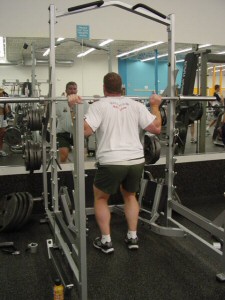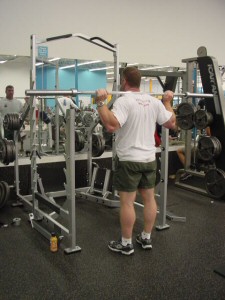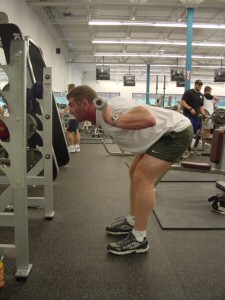Exercise of the Month: The Good Morning
Mike Furci home / Fitness Channel / Bullz-Eye Home
Bending over to pick something up can be
a very dangerous move if done with a rounded back. Most people in their
lifetime will have an injury to the lower back. One way to help prevent
such injuries is to do the good morning.
Performing the good morning strengthens the posterior chain, which includes the
lower back, glutes and hamstrings. The glutes (butt) and the hamstrings are responsible
for hip extension while the muscles of the lower back (erector spinea) are contracted
statically.
Because of the large degree of hip flexion, the gluteus maximus and the hamstrings
are utilized throughout the movement. The glutes work in unison with the hamstring
to extend the hips in the concentric (raising) part of the movement. The hamstrings,
located on the back of the upper thigh, become more involved as you begin to
decrease the degree of hip flexion while raising the weight. The erector spinea,
which run the length of your spine on both sides, are statically contracted throughout
most of the movement, keeping the normal curvature of the spine. A static contraction
of the rhomboids and the trapezius muscles help maintain the shoulders.
Extension of the body occurs when the upper body, torso and pelvis rotate up
and back. The biggest mistake I see with this movement is allowing the back to
“round” and magnifying the kyphotic (upper back) curvature while de-emphasizing
the lordotic (lower back) curvature. I need to add that a slight curve of the
upper back will present no danger and will happen to most while using heavy weight,
but if you look like a big question mark (?) while performing the exercise,
that’s a different story.
The Good Morning
Place a barbell on a squat rack at the same height you would use while performing
the squat. Load the bar with the appropriate weight and step underneath it. Put
your body directly in the center of the bar. Place the bar in the same spot that
you use when performing the squat. Place your feet approximately shoulder width
apart, directly under the bar. Maintain the lordotic curve in your low back with
your chest up. Your head is pointed straight ahead or slightly upward. Do not
look down. The body follows the head.
Once you are in position, take two to three small steps back.
Take a deep breath, and slightly flex your knees. Under control, start to bend
forward, maintaining the normal curvature of your lower back. As you lower your
torso, keep looking straight ahead. This will help keep your back in its proper
position. Lower your torso until it is parallel to the floor and then reverse
directions and raise your torso to the starting position.










